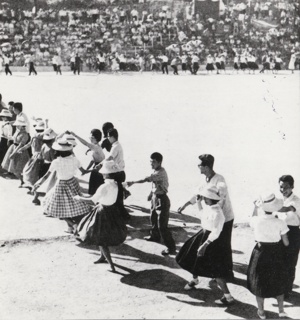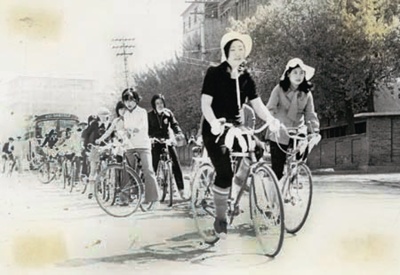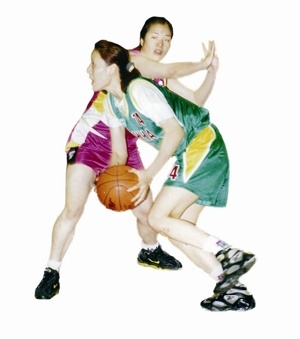Ewha plays leading role in women’s sports

In 1892, the School of Ewha founded by Mary F. Scranton initiated sports education, which became the root of women’s sports in Korea. Ewha also stood at the forefront of women’s university sports through many accomplishments in various fields for over a century. The Ewha Voice recollected the history of Ewha sports.
Following the preferred images of Korean women back in the 19th century of the Chosun Dynasty, girls were constantly told: Walk in small strides with modesty. Keep your footsteps narrower than the size of your foot. Never run frivolously.
Despite such trend, Ewha teaching girls gymnastics raised public’s criticism, indeed.
“Disagreeing with Ewha teaching gymnastics, many noble families sent servants to have their daughters picked up from school. ‘Women from Ewha should not be a noble family’s wife’ was one of the social trends,” reads Yi Kyung-ock (Human Movement Studies) in Developmental Direction of Ewha Sports in the 21st century.
However, Ewha went on with its gymnastics classes and later on, students learned to play various sports wearing the Korean traditional dress, hanbok. Also, Jeannette Walter, one of the foreign missionary teachers at Ewha, developed a skirt with shoulder straps to hold the hanbok skirt from falling down, which became the origin of the modern hanbok.
This also led to producing pumpkin-shaped shorts for women, called bloomers. The new form of clothing made it more comfortable for students to move and exercise. Thus, many students gathered and played various sports that had been restricted by uncomfortable clothes and social values at that time.
In 1945, Ewha established the first Human Movement Studies major among Korean universities. It naturally led to employing more professors for physical education who taught new western sports such as cycling, fencing, and social dance.

“On the first day of American folk dance class, about 2,000 students crowded in the cafeteria with the excitement of learning something new,” said Cho Sung-whan, an emeritus professor of the College of Health and Sciences who graduated from Ewha in 1949 and came back as a professor during the 60s.
“The students kept wanting to learn other new sports, like cycling, since nobody knew how to ride a bicycle back then. So we gave a free cycling lesson after class for all students of Ewha.”
Since the late 60s, Ewha aimed for a well-rounded education, providing intellectual, moral, and physical education. Thus, Ewha tried to engage its students in many large sporting events along with the May Day festival.
“During the May Day, Ewha threw a big ballroom dance party with partners in the playground, called the ‘Ssang-ssang Party,’” said professor Lee In-sook (Human Movement Studies) who studied Human Movement and graduated from Ewha in 1975. “Also, the annual cycling competition was remarkable, where students cycled approximately 10 kilometers from Ewha to Eunpyeong-gu, which even called for Seodaemun-gu police’s escort due to its great scale.”

In the 1980s, university sports leagues gained the spotlight, and Ewha led the women’s. The Ewha Softball Team was especially famous for winning the National Women’s University Softball League for three consecutive years.
Moreover, the volleyball team traveled to other countries like Thailand and Japan for friendly matches, representing Korean women’s university volleyball.
With such accomplishments, thousands of Ewha students gathered to stadiums and cheered for their classmates. Sookmyung Women’s University being Ewha’s most competitive rival at that time, the two shools encountered in the finals every year. The Ewha-Sookmyung matches were always sizzling.
“For the four years I played volleyball, Ewha beat Sookmyung most of the time,” said Jung Bog-ja (’88, Human Movement Studies) who is a professor at Gachon University. “Every game, the Jamsil Sports Complex was packed with girls cheering for their team’s victory. It truly brought the Ewha community together and inspired students to have even stronger pride as Ewha students.”

While other sports such as basketball, softball, and volleyball were already achieving substantial accomplishments, it was only shortly after 1990 when a women’s soccer team was created at Ewha, the first in Korea as well. Although it consisted of both professional and non-professional players, the Ewha Soccer Team played in many international competitions as the Korean National Women’s Soccer Team. The team also had a friendly match with the North Korean national team.
“Instead of playing against each other, the North and South Korean teams mixed their players and played a game, which was quite meaningful,” said Im Eun-ju, the first Korean female international soccer referee who coached the Ewha Soccer Team in 1993.
As many Ewha students remember, the heyday of Ewha sports continued until the early 1990s. However, later in the decade, Ewha stopped accepting elite athletes to focus on its fundamental goal as an academic institution. As a result, the sports teams in Ewha inevitably faced a lack of competent players and in the end, had to disband.


